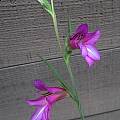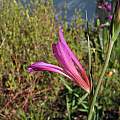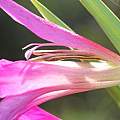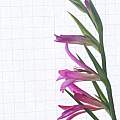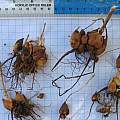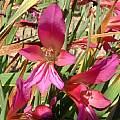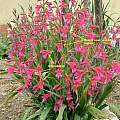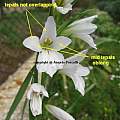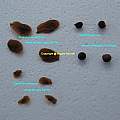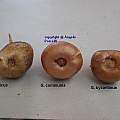Quick Characteristics:
| Flower Colors: | purple, white |
Gladiolus italicus has a broad distribution from southern Europe to parts of Asia growing on rocky hillsides, grassy areas, open forests and in fields. It flowers from March to July. Theophrastus wrote that the corm when pounded and mixed with flour made bread sweeter. It is distinguished from other European Gladiolus by having anthers that are longer than the filaments. Flowers are loosely arranged and facing various directions, pale pink as well as purple-pink to magenta with a pale blotch outlined in purple on the lower lobes. There are 5 to 15 flowers on the spike. Photos 1-2 taken by Mary Sue Ittner show the flowers of a plant grown from seed labeled G. italicus. Photo 3 was taken by Nhu Nguyen. Photos 4-6 by M. Gastil-Buhl include a close-up showing the relative length of anthers and stigma, a flower spike and corms still in the clusters as found when excavated against a 1 cm grid. The corms were found growing between 3 to 5 inches deep, including layers of added compost and grit. All of these corms and more grew in 2 years from just 4 juvenile corms.
Photos from Angelo Porcelli. The first is a close-up taken in habitat. The last three photos were taken from his article Gladiolus of Southern Italy. In this article he explains the difference between this species and Gladiolus byzantinus and Gladiolus communis. Gladiolus italicus is smaller, averaging 20 to 23 inches (50-60 cm) and has flowers with an "open" shape; the lateral tepals are oblong, narrow and well spaced, not overlapping the upper tepal and the two lower ones. Seed is quite different in this species from the other two which have winged seed. Seed looks like small pepper grains with three to four angles. Corms have a peculiar net on the tunics, especially on the top of the corm, and are a rather light brown color. This species is highly bulbilliferous and increases by cormlets at an alarming rate and a single corm will turn in a clump in a few years.
